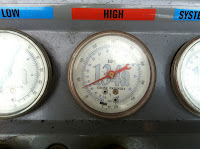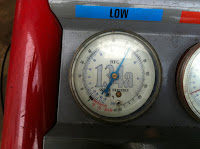First thing, when an air conditioner doesn't work in a vehicle, we must do a simple visual inspection to ensure that everything is present and accounted for. Sometimes, the simplest thing can make the air conditioner not function. Belts, electrical connections, and lines and hoses must all be verified present. Ensure that the condenser has not sustained major damage.
Next, start the vehicle and turn the air conditioner on. See the compressor? If the clutch fails to engage to turn the compressor itself, the Freon in the system has no way of moving through the system. Remember our previous post about how A/C works in your vehicle? Most likely, if your A/C doesn't work the compressor is not turning at all, only free wheeling on the pulley.
If the compressor clutch engages and turns the compressor constantly while the A/C is on, then you most likely have low Freon levels, but high pressure. R134A refrigerant is a smaller molecule than air and will escape over time, leaving only hot air and residual pressures in the system. The clutch will engage, but the system has no refrigerant to compress and turn in to liquid. Evacuate the refrigerant and recharge the system at this point and everything will function normally.
In the case of this Express, however, the Freon levels were verified good through a vehicle history and testing pressure. The system was recharged only a year ago and the clutch was not engaging the compressor.
We connect the lines of the A/C gauges to the high and low ports of the system to test pressure. The low pressure port on this particular vehicle is located on the receiver/dryer. The low side port can always be identified in an R134A system as being smaller than the other.
 |
| The high pressure port is located on the firewall on a high-pressure line. |
 |
| The low pressure port is located just to the right of the red positive battery terminal on the side of the receiver/dryer |
After connecting the gauge set, we take pressure readings from the system. Here, we can see that we have 74psi of pressure on both the high and low pressure side. This is totally normal and within specification for this vehicle. You'll want your pressure to be between 60-80psi with the system not running. Also, check to see if pressures are equal between the high and low pressure sides. Any variance in this will indicate a blockage in the system from a pinched line or hose, a plugged orifice tube, or some other issue. Seeing as how my pressures are normal, the system should work! At this point, we have to look at an electrical problem.
 |
| High pressure side at 74psi |
 |
| Low pressure side at 74psi |
The first thing to check when you suspect an electrical problem is all of the connections at the pressure switches and compressor. Often times, I have seen a plug that someone has inadvertently unplugged or has forgotten to replace after a repair. If everything is plugged in and working, the dangerous part comes.
Remember watching Norm Abrams on the New Yankee Workshop? He would always pause before using a power tool to talk about shop safety. Here's our speech:
We at DIY are only concerned about your safety. If you feel at ALL uncomfortable working around a running engine, then stop. DO NOT attempt any repair or diagnosis on a running engine if you do not feel COMPLETELY comfortable working around moving parts that can possibly injure you.
With that out of the way, let's test the compressor clutch coil for battery power.
Locate the plug for the compressor clutch. It is always located on the back of the compressor pulley, and on GM products it is a flat plug with two terminals. One is chassis ground and the other is battery voltage signal. If everything is working correctly on the pressure switch side and the other checks the vehicle's system makes to ensure proper pressure, we should have battery voltage at this connection.
 |
| Pin the terminals in the connector to test for voltage. |
After pinning the terminals in the connector with your voltage meter or test light, start the engine and turn the A/C on. Ah ha! We have battery voltage at this terminal. This means that the system is functioning properly right down to the compressor clutch coil. With all systems functioning, there is no reason other than a bad compressor coil for this system to be inoperative.
After replacing the compressor clutch coil, we now have functioning air conditioning and a happy customer!
For any questions about testing or diagnosing a problem with your vehicle, feel free to email us at DIYfixyourcar@gmail.com

How do you bypass pressure switch to top up system?
ReplyDelete2003 Express 2500 - During Winter months when there was no AC running, I heard some bad sounding pulley going on. I accused the idle pulley, since that is the usual suspect. It stopped, then suddenly we have record breaking high temps in the upper 80's in North Texas in February. The noise stopped weeks ago, but when I turn on the AC, I do not hear the clutch kick in. Thank you for this article, as it pretty much assures what I was thinking. Unfortunately, the clutch and pulley assembly cost almost as much as the whole compressor with all that new, yet on the bright side, I won't have to vac/recharge the system. I still need to test and see it with my own eyes, although I am pretty sure it's the clutch. Will update soon.
ReplyDeleteOh no A.C. is an essential part of car and if it is not working properly then the whole journey become crap. I think you should get the Chevrolet Express Repair Manual that will guide you in its repairing.
ReplyDeleteThese are some of the major causes of bad indoor air quality. And all that's written here is necessary for better home health. Heating and Cooling Newmarket
ReplyDeletereally amazing and useful blog thanks for shared.
ReplyDeleteChiller Transport Services in UAE
really great article i will share it my all contacts.
ReplyDeleteBest Web Design Services USA
The thorough testing and diagnosis of the 2003 Chevrolet Express A/C exemplify about car. Does A VPN Slow Down Your Internet? The attention to detail, expertise, and dedication to resolving the problem efficiently showcase the professionalism.
ReplyDelete